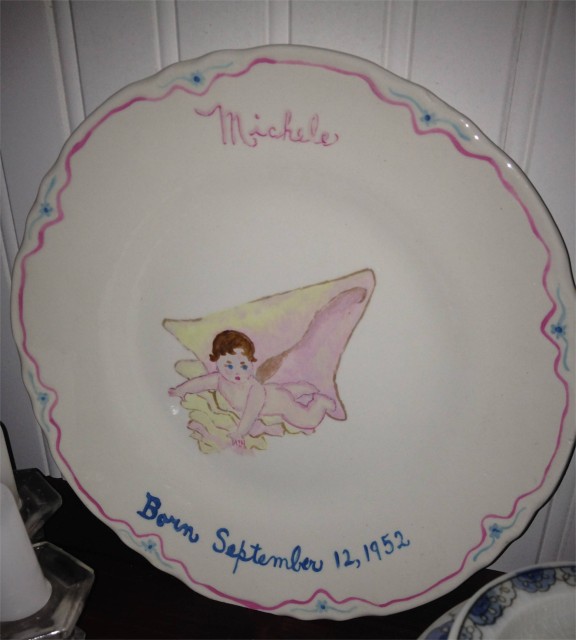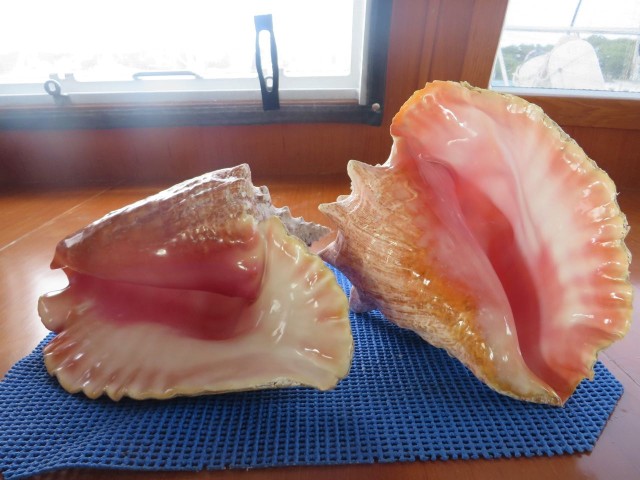It’s no secret that I love the coral-colored queen conch shell. I took a look back at some of my old blog posts from 2014 and surprised myself at the many photos of conch shells – the ones we collected (Beach and Sea Treasures), the conch horns Al made (Sounding the Conch Horn 1 & 2), and the various ways people decorate with conch shells.

From the Bahamas National Trust: The Queen Conch’s scientific name is Strombus gigs. “The conch is a large sea snail. It has a large shell with a short conical spire with blunt spikes. The shell’s exterior is orangeish (not always apparent because of algal growth; the aperture (opening to the inside of the shell) is a shiny rosy pink colour. The mollusk itself has a mottled gray head with a large proboscis (like a nose or beak) and long eye stalks with eyes at the end. Beneath the shell is a strong foot with a “claw” like a pointed toenail. Conchs are either male or female just like people. The male has a black arm over his right eye. The female conch has a groove that runs down the right side of her foot.”
Conch shells have been rare during this winter of 2015-2016. We have not been able to collect as many conch shells as 2014, none at all for quite a while. How could I match the 24 that I brought home from our first trip?? I’ve been pretty disappointed. 🙁
Then, late one afternoon, at the Hope Town Inn and Marina, I spied a fishing boat on the dock cleaning the day’s catch. A closer look and wowweee, the guy was cleaning conch, something I had never watched before. I didn’t want to bother him while he was working but couldn’t resist watching and asking a few questions. Also grabbed my camera for photographs, which I tried to take discreetly.
This was my first opportunity to see someone “crack” or “knock” a conch, the process of separating the animal from its lovely home. The tools are simple, a hammer, screwdriver, and knife, but the technique is challenging.


Al agreed that I could have three conchs to take home, but after he left, I talked the conch guy into one more. They were beautiful mature specimens.


It’s also no secret to anyone who knows me well that I do not like to eat conch. I’ve tried, tasting conch salad, conch fritters, cracked conch. I just don’t care for the texture or taste. So there won’t be any photos of any conch specialities.
The Queen Conch is endangered because many other people do like to eat conch in all forms. So much so that the Bahamas exports $5-$7 million dollars worth of conch each year. The February 1, 2016 edition of The Abaconian, ran an article about the status of the conch population. Over-harvesting has already led to commercial extinction in Florida and Haiti. Bahamian regulations require that any conch harvested must be fully mature with a lip thickness of 15 millimeters (about .2 inches.) Successful mating and reproduction requires a minimum density of fifty adult conch per hectare with 100 conch per hectare for sustainability. (The hectare is a metric unit of area defined as 10,000 square meters, 100 meters by 100 meters. Picture two footballs side by side for a rough estimate of a hectare’s size). Research has confirmed that in every commercial fishing ground surveyed over the past five years has less than 10 conchs per hectare, a density which cannot sustain reproduction.
As we travel around the Abacos, we see evidence of how many conch are harvested, and that many are only juveniles without a fully developed mature lip.

The day we dinghied around Snake Cay, we stumbled upon even more conch graveyards.







Leave a Reply